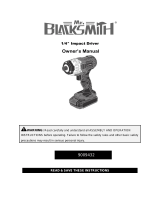
6
ENGLISH
ENG
drugs, alcohol or medication.
A moment of
inattention while operating power tools may
result in serious personal injury.
b)
Use personal protective equipment.
Always wear eye protection.
Protective
equipment such as dust mask, non-skid safety
shoes, hard hat, or hearing protection used for
appropriate conditions will reduce personal
injuries.
c)
Prevent unintentional starting. Ensure the
switch is in the off-position before
connecting to power source and/or battery
pack, picking up or carrying the tool.
Carrying power tools with your finger on the
switch or energising power tools that have the
switch on invites accidents.
d)
Remove any adjusting key or wrench
before turning the power tool on.
A wrench
or a key left attached to a rotating part of the
power tool may result in personal injury.
e)
Do not overreach. Keep proper footing and
balance at all times.
This enables better
control of the power tool in unexpected
situations.
f)
Dress properly. Do not wear loose clothing
or jewellery. Keep your hair, clothing and
gloves away from moving parts.
Loose
clothes, jewellery or long hair can be caught in
moving parts.
g)
If devices are provided for the connection
of dust extraction and collection facilities,
ensure these are connected and properly
used.
Use of dust collection can reduce
dust-related hazards.
4) Power tool use and care
a)
Do not force the power tool. Use the
correct power tool for your application.
The
correct power tool will do the job better and
safer at the rate for which it was designed.
b)
Do not use the power tool if the switch
does not turn it on and off.
Any power tool
that cannot be controlled with the switch is
dangerous and must be repaired.
c)
Disconnect the plug from the power
source and/or the battery pack from the
power tool before making any adjustments,
changing accessories, or storing power
tools.
Such preventive safety mea ures reduce
the risk of starting the power tool accidentally.
d)
Store idle power tools out of the reach
of children and do not allow persons
unfamiliar with the power tool or these
instructions to operate the power tool.
Power tools are dangerous in the hands of
untrained users.
e)
Maintain power tools. Check for misalign-
ment or binding of moving parts, breakage
of parts and any other condition that may
affect the power tool's operation. If
damaged, have the power tool repaired
before use.
Many accidents are caused by
poorly maintained power tools.
f)
Keep cutting tools sharp and clean.
Properly maintained cutting tools with sharp
cutting edges are less likely to bind and are
easier to control.
g)
Use the power tool, accessories and tool
bits etc. in accordance with these instruc-
tions, taking into account the working
conditions and the work to be performed.
Use of the power tool for operations different
from those intended could result in a
hazardous situation.
5) Service
a)
Have your power tool serviced by a
qualified repair person using only identical
replacement parts.
This will ensure that the
safety of the power tool is maintained.
Wear ear protectors with impact drills.
Expo-
sure to noise can cause hearing loss.
Use auxiliary handles supplied with the tool.
Loss of control can cause personal injury.
Hold power tool by insulated gripping surfaces,
when performing an operation where the
cutting accessory may contact hidden or it’s
wiring own cord.
Cutting accessory contacting a
“live” wire may make exposed metal parts of the
power tool “live” and could give the operator an
electric shock.
Pull the plug out of the plug socket before any
adjustments or servicing are performed.
Avoid inadvertent starts by always unlocking the
switch when the plug is removed from the mains
socket or in case of a power cut. This is not neces-
sary in the case of SBE 1000, SBE 1100 Plus (with
restart protection).
Ensure that the spot where you wish to work is free
of
power cables, gas lines or water pipes
(e.g.
using a metal detector).
Smaller workpieces must be secured such that
they are not carried along with the drill bit when
drilling (e.g. by clamping in a vice or on a work
bench with screw clamps).
Keep hands away from the rotating tool! Remove
chips and similar material only when the machine
is not in operation.
Metabo S-automatic safety clutch. When the
safety clutch responds, switch off the machine
immediately! If the tool jams or catches, the power
supply to the motor is restricted. Due to the strong
3 Special Safety Instructions
17026970_0511 SB_Bauk10 NAFTA.book Seite 6 Freitag, 13. Mai 2011 8:38 08








